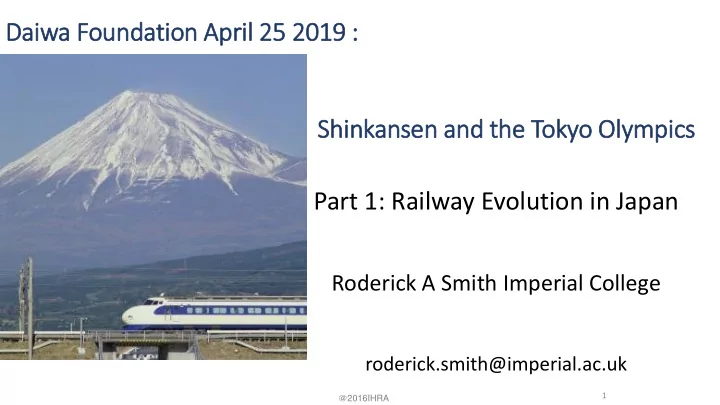

Daiwa Foundation April 25 2019 : : Shinkansen and th the Tokyo Oly lympics Part 1: Railway Evolution in Japan Roderick A Smith Imperial College roderick.smith@imperial.ac.uk 1 @ 2016IHRA
Agenda: • Edo becomes Meiji Tokyo • Harnessing of Western technology • Birth and growth of the railway • Connecting the Yamanote line • Kanto earthquake, birth of the subway • Wartime destruction and post war rebuilding • Capacity issues: birth of Shinkansen, Tokyo Olympics • Features of a journey on the shinkansen
Goods being carried in the mountains near Ome
Background to the transformation of Japan covering the first railway, to the end of the Russio-Japanese war, nationalisation and the opening of Tokyo Station in 1912: • The Meiji period, from 1868 to 1912, started when the 15 year old Emperor Motsuhito moved from Kyoto to make the new capital in Edo, renamed Tokyo • Japan rapidly changed from an isolated feudal system to a modern outward looking country by adopting western technology at a frantic pace • Missions reported back from Europe and the USA, more than 3000 foreign technical experts came to Japan, o-yatoi-gaikokujin. Japan proved to be a rapid learner, soon establishing independence • Some communication highlights: Domestic telegraph Tokyo-Yokohama 1869, international telegraph 1870, mail system 1871, and in 1874 Yomuri Shinbum newspaper
Two key missions to Europe and the US: 19 Satsuma students 1865 Choshu Five 1863 Inoue Masaru, first Director of Japanese Railways, so-called はるばるとこころつどいてはなさかる Father of the (Harubaru to kokoro tsudoite hana sakaru) railways ‘When distant minds come together, cherries blossom ’
Background to railways The first railway in Japan between Tokyo (Shimbashi) and Yokohama, 29km, opened in 1872 . Built with British help using British locomotives, rails, rolling stock and operations staff Single track for a steam locomotive that travelled at a top speed of ~30 kph, 9 return trips every day The rails were set at 1,067 mm gauge, establishing the standard gauge in Japan that remains in use today 17 later in July 1889 it became possible to travel the entire way from Tokyo to Osaka by train. A single departure per day made the 515 km journey in 20 hours.
Edmond Morel engineer of first railway in Japan Experience in many parts of British Empire Reason for narrow gauge choice? But loading gauge very generous Died of TB Nov 1871 Buried in Foreigner’s Cemetery Yokohama Wife died a day later (Japanese?)
First loco in Japan 0-6-0 tank by Vulcan Foundry Manchester Preserved in the Saitama railway museum. Manufacture of locomotives, rails, bridges, needed larger scale steel production which was to come to Japan later, starting at Yawata Kyushu
Growth of the railway Private investment was encouraged which allowed rapid expansion of the system From 1885-1890, Government routes grew from 270 to 886 km, whilst private lines expanded from 299 to 1365 km By 1905, 68% of the network was private Confidence in Japan grew quickly, with victory over China 1895, the Anglo-Japan Alliance in 1902 and the victory over Russia in 1905 For largely strategic reasons, the government nationalised most of the railway in 1906-1907 5 years later, at the end of the Meiji era, the Government ran 90% of the 8660 km route opened
Extending the railway from Shinbashi (in foreground) to present Tokyo Station
Effect of Great Kanto Earthquake Manseibashi Station old terminus of the Chuo Line, before and after the great Kanto Earthquake 1 September 1923
Population growth, urbanisation Oil shocks Falling birthrate, ageing society Korean war Environment, energy Reconstruction War Rapid economic growth Fukushima 1920 1940 1960 1980 2000 2020 JGR become JNR Privatisation Great Kanto Earthquake Maglev Tokyo Olympics construction Shinkansen starts First Subway in Tokyo Growth of domestic air Highway construction, auto travel ownership Timeline: End Meiji Era to present
The first subway in Asia opened in Tokyo on 30 Dec 1927, 2.2 km between Ueno and Asakusa Post War concentration of people into the Tokyo metropolis eventually led to this:
1935 “ The train came out of the long tunnel into the snow country.” Nobel prize in 1968, 3 rd Japanese, first in Literature
Widespread destruction of Japanese cities at the end of WWII required a huge rebuilding programme, including the railways which somehow continued to function but became increasingly short of capacity and out dated The switch of military scientist to civilian work proved to be a major benefit to the railways Matsudaira, Tadashi was a great example: Working at the Railway Technical Institute in Tokyo, he applied his aeronautical skills to solving the bogie vibration issues eventually paving the way for the shinkansen
Plans for the ambitious dangan ressha (bullet train) project were launched in December 1938. A standard-gauge railway that would link Tokyo with Shimonoseki in nine hours, completion date of 1954. The war caused the abandonment of this plan. In 1955 Shinji Sogo, then age 71, had been brought out of retirement to head JNR. 50th anniversary of the founding of JNR’s forerunner, the Railway Technical Institute organized a public forum at on May 30, 1957. Director Takeshi Shinohara reveiled an ambitious blueprint for modernization titled “The Possibility of a Three -hour Rail Trip Between Tokyo and Osaka.”
Domestic opposition was strong, overseas opinion dismissive. Many took the view that the ago of the train was over, the automobile was king The project was likened to “the world’s three great follies”: the Great Wall of China, the Egyptian pyramids and the battleship Yamato, enormous, costly things that turned out to be useless. However, with strong leadership from Sogo, later called the Father of the Shinkansen , and a loan from the World Bank, the Shinkansen opened on 1964, coinciding with the Tokyo Olympics
Emperor's nephew’s birthday party Oxford 1969: Beginning of a long association with Japan: • Scores of visits • Japanese wife • Imported Series 0 shinkansen to NRM • Strong contacts with Japanese railway companies
Main systems of high speed rail People
Trust in, and love of, the railways by the Japanese people
Recommend
More recommend